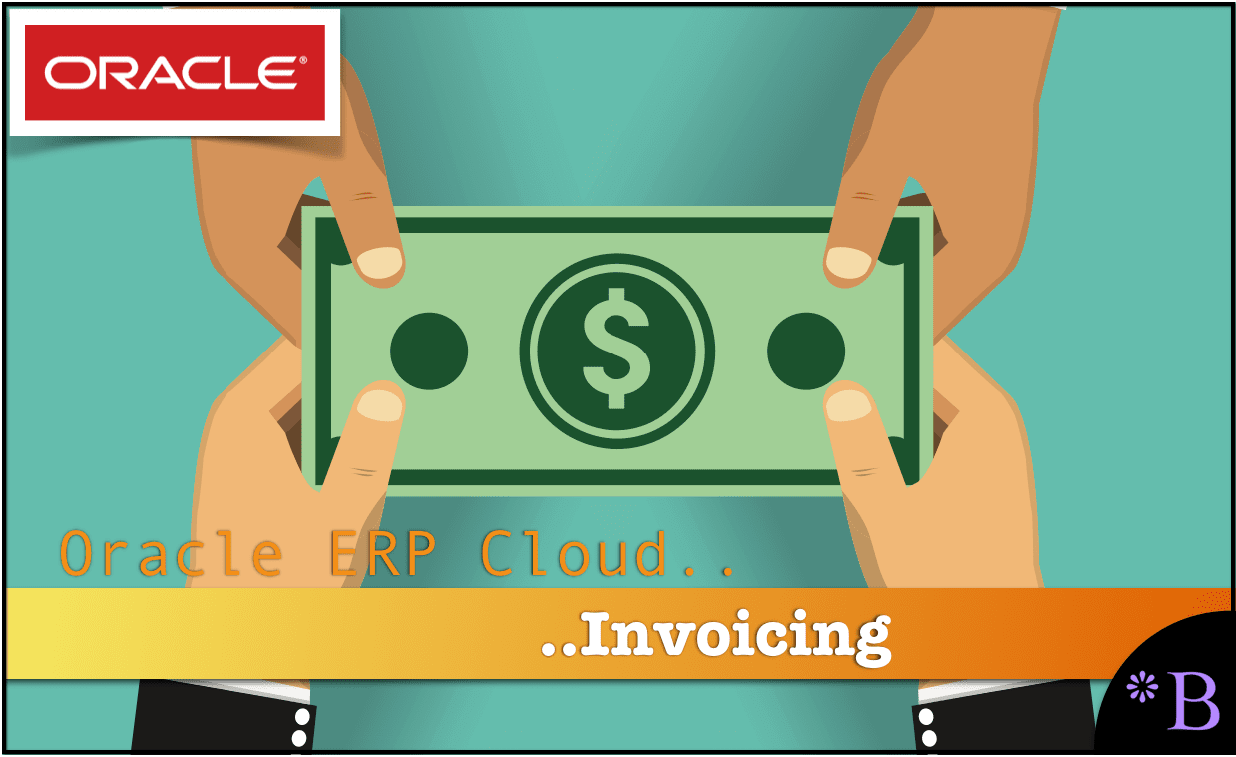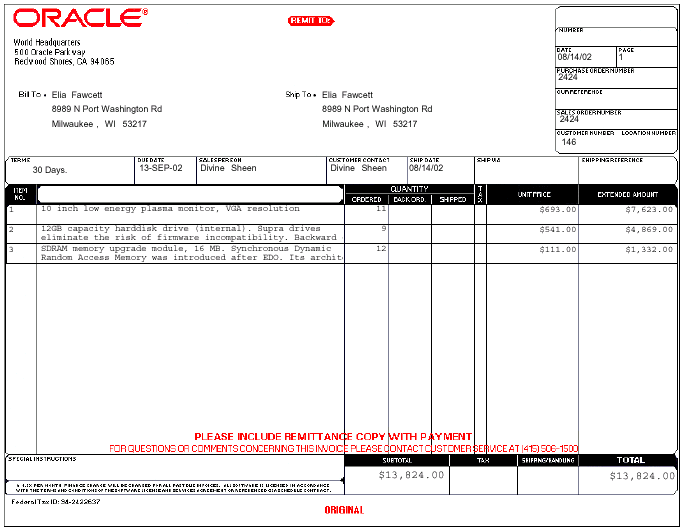How to Understanding Oracle ERP Cloud Invoicing
Executive Summary
- In this article, we cover some common areas of Oracle ERP Cloud invoicing.

Introduction
In this article, we will cover some basic topics around Oracle ERP Cloud invoicing. Oracle ERP Cloud has a great deal of functionality in invoicing, and this is just coverage of a few important areas.
Our References for This Article
If you want to see our references for this article and other related Brightwork articles, see this link.
Lack of Financial Bias Notice: The vast majority of content available on the Internet about Oracle is marketing fiddle-faddle published by Oracle, Oracle partners, or media entities paid by Oracle to run their marketing on the media website. Each one of these entities tries to hide its financial bias from readers. The article below is very different.
- This is published by a research entity, not some dishonest entity that is part of the Oracle ecosystem.
- Second, no one paid for this article to be written, and it is not pretending to inform you while being rigged to sell you software or consulting services. Unlike nearly every other article you will find from Google on this topic, it has had no input from any company's marketing or sales department. As you are reading this article, consider how rare this is. The vast majority of information on the Internet on Oracle is provided by Oracle, which is filled with false claims and sleazy consulting companies and SAP consultants who will tell any lie for personal benefit. Furthermore, Oracle pays off all IT analysts -- who have the same concern for accuracy as Oracle. Not one of these entities will disclose their pro-Oracle financial bias to their readers.
This video shows how setting up an invoice in Oracle works through the user interface.
Oracle ERP Cloud offers the following invoice types.
- Credit Memo
- Debit Memo
- Mixed
- Prepayment
- Expense Report
- Withholding
- Retainage Release
Invoice Focus Area #1: Standard Reports in Oracle ERP Cloud
There are many, over 25, standard reports available within Oracle ERP Cloud. A few examples include:
- Payables Matching Hold Detail Report
- Payables Key Indicators Report
- Payables Invoice Register
It is only necessary to review the standard reports to determine what requirements the implementing company has that are not met by these standards reports.
Invoice Focus Area #2: Supplier Portal in Oracle ERP Cloud for Invoicing
The supplier portal allows suppliers to manage their invoices and to have more integration and visibility with suppliers.
This video was removed from YouTube.
Here is an example video that shows some of the capabilities of the supplier portal. This portal allows both the supplier and the customer to see the status and then act on the invoices.
Items to note that are at the user’s fingertips are shown in the following table.
Oracle ERP Cloud Supplier Portal Areas
| Category | Functionality |
|---|---|
| Orders | Manage Orders |
| Orders | Manage Schedules |
| Orders | Acknowledge Schedules in Spreadsheets |
| Agreements | Manage Agreements |
| Shipments | Create ASN |
| Shipments | Create ASBN |
| Shipments | Upload ASNO or ASBN |
| Shipments | View Receipts |
| Shipments | View Returns |
| Deliveriables | Manage Deliverables |
| Consignment Inventory | Review Consumption Advices |
Naturally, the state of any invoice can be altered in the Supplier Portal, including editing and deleting and many other changes.
Invoice Focus Area #3: Tracking Invoices or Invoice Status in Oracle ERP Cloud
Invoices can be tracked in Oracle ERP Cloud. There are two different ways to obtain this functionality.
Track and Trace in Oracle ERP Cloud
One area of functionality is called “Track and Trace” functionality in Oracle ERP Cloud. There is a connection between a business process step or sequence and a document — with the invoice, in this case, being the document.
However, in order to use this functionality, Track and Trace must be activated in Oracle ERP Cloud.
This functionality is covered in the following video.
This integrates with blockchain in the following way.
Oracle Intelligent Track & Trace blockchain application is a forward-leaning business ready technology that makes it easy for customers to get faster time to value and faster resolution of business transactions. It affords end-to-end supply chain visibility. By recording non-disputable transactions from the respective partner enterprise applications, trust is established throughout the network. With this Oracle Intelligent Track & Trace blockchain application, customers can transform their businesses with new and fast-changing innovations, accelerated business processes and reduced cost and risk.
This SaaS application is built on the Oracle Blockchain Platform and can be integrated with a range of enterprise applications such as Supply Chain Management (SCM), Enterprise Resource Planning (ERP), Customer Experience (CX), and Internet of Things (IoT).
A timeline view shows tracking history with drill-down displays of business documents that are securely committed to the distributed ledger. – Oracle Intelligent Track and Trace
There is little evidence that this functionality is widely implemented, and Oracle’s blockchain, as with all blockchain is filled with false claims, as we cover in the article Is Blockchain All That Innovative or is it Being Overhyped?
Therefore, tracking invoices, and receiving things like notifications is part of a much larger solution from Oracle.
Changing invoices leads to the next invoice area.
Invoice Status
Another way of obtaining tracking is by using the invoicing dashboard which provides the status of invoices. However, the limitation is that in some customers the status that is presented in Oracle ERP Cloud does not match what customers want to see.
Invoice Status Screens
By selecting “Invoices” in Oracle ERP Cloud, one can see the “subscreens” or screen inserts that provide information about invoices from the main Invoices screen.
- Scanned Invoices Queue
- Recent Invoices
- Invoices Requiring Attention
- Available Prepayments
- Process Monitor
The Recent Invoices Subscreen
The Recent Invoices subscreen has the following statuses.
- Invoice Number
- Amount Supplier
- Supplier Site
- Verification Status
- Last Updated Date
- Source
- Description
The Invoices Requiring Attention Subscreen
The Invoices Requiring Attention subscreen has the following standard statuses.
- Requiring Approval
- Pending Approval from Others
- Rejected
- On Hold
- Installments on Hold
Something that one should notice is that there are not statuses for whether the invoice was sent.
Invoice Focus Area #4: Adding to Invoices — Importing Adding, Subtracting, etc.
The invoice in Oracle ERP Cloud comes with the following standard fields.
Oracle Invoice Feilds
| Field Category | Field Name |
|---|---|
| General Information | Business Unit |
| General Information | Transaction Source |
| General Information | Transaction Type |
| General Information | Transaction Number |
| General Information | Document Number |
| General Information | Transaction Date |
| General Information | Accounting Date |
| General Information | Salesperson |
| General Information | Invoicing Rule |
| General Information | Attachments |
| General Information | Currency |
| General Information | Transaction Total |
| General Information | Lines |
| General Information | Tax |
| General Information | Freign |
| General Information | Charges |
| Customer | Bill to Name |
| Customer | Bill to Site |
| Customer | Ship to Name |
| Customer | Ship to Site |
| Customer | Payment Terms |
| Customer | Due Date |
| Invoice Lines | Line |
| Invoice Lines | Item |
| Invoice Lines | Description |
| Invoice Lines | Memo Line |
| Invoice Lines | UOM |
| Invoice Lines | Quantity |
| Invoice Lines | Unit Price |
| Invoice Lines | Amount |
| Invoice Lines | Details |
| Invoice Lines | Number |
However, in many cases, this does not cover the fields that the customer wants to have.
Oracle has a Cloud ERP Adapter of the Oracle ICS that allows a number of items to be imported to the invoice.
This video illustrates the functionality.
Within this adapter, one can upload events to be incorporated into the invoice.
Examples of what can be imported are as follows.
- Import Payable Invoices
- Import Supplier Bank Accounts
- Retrieve Funds Capture Acknowledgments
- Import Credit Data
- Process Receipts Through Lockbox
- Import Autoinvoice
- Import Reconciliation Report Data
- Import Billing Data
- Import Revenue Basis Data
Oracle explains this as follows:
The ERP Object Attachment Service supports the automatic upload of attachments for Oracle ERP Cloud business applications. An attachment represents a collection of meaningful business information that is commonly captured as a separate file, text, or Internet URL. Attachments are used to supplement and provide key additional information to enhance daily business operations and better track financial activities or events.
Business enterprises often require the capability to efficiently associate specific attachments with a particular business entity or collection of business entities. For example:
Payables invoices may need to be associated with supporting documents such as duplicate invoices, payments, etc.
Account receivables transactions may need to be linked to customer-centric documents
Purchase orders may need supplementary files attached to indicate additional details related to specific goods or services procured or the nature of the overall purchase. – Oracle Blog on Object Attachment Service
This has the negative feature of requiring these skills to bring up areas that are frequently required by users of Oracle ERP Cloud. Not all companies have the resources who are trained to bring up the OCI.
Oracle Printing Options

The output of Oracle ERP Cloud invoicing is quite basic. If companies want something different, there are not a lot of options provided within Oracle. Companies may end up having to adjust the invoice using image manipulation applications like Adobe’s Creative Suite or similar.